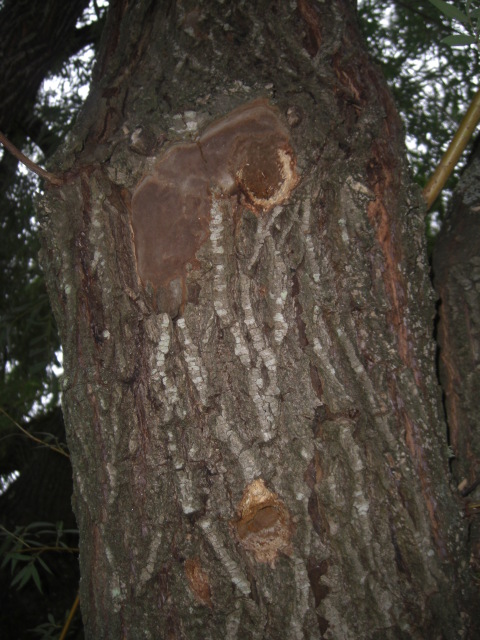QuestionQUESTION: I have a mature willow tree that has developed a light brown fungus on the trunk of several of the main branches. Next to the fungus there are holes about 3" across and 3" to 4" deep. What is it and can it be treated? This is a really beautiful tree and I would hate to lose it!
ANSWER: Sounds like a decay fungus fruiting body--like the flower of a plant. One of the life stages of the fungi is producing a conk or mushroom type fruiting body. Decay fungi enter the tree through a wound in the bark and slowly eat away at the woody cells. They do not harm the living cells just under the bark. As the fungi grows it will hollow out the tree trunk and even hollow out limbs as the fungi moves up the tree trunk. Tree can live many many years as hollow trees. IF the hollow gets into the limbs the limb could break off during a storm.
The woody cells are dead cells and not associated with the healthy of the tree except for strength.
Trees can and do live many many years with their trunks completely hollow. Trees have the capability to seal off the decay fungi and slow the growth of the decay. IF the large limbs start to break off and the end near the trunk is decayed or hollow then the tree may have reached a point that it could be a hazard. And then it is only a hazard if it is locates near a structure that could be hit by a falling limb. Yours sounds a long way from that stage.
Some hollow trees may have so little healthy tissue surrounding the hollow area that they must be regarded as dangerous, but this is by no means the norm. Trees do not become hollow overnight - it can take decades - and while the center of the tree (the heartwood) may be decaying, the tree continues to lay down healthy wood (sapwood) around the outside of its trunk. This results in the formation of a cylinder, the strength of which depends upon the percentage of healthy to unhealthy tissue.
The first sign of the tree being a danger is large limbs breaking off and these are hollow. This means the decay has reach the limbs and is fairly extensive.
There is not any treatment that can remove the decay and you really would not want to do that anyway. The best thing is to keep the tree healthy by fertilizing it with 10-10-10 fertilizer at the rate of 1 lb of fertilizer per inch of trunk diameter scattered around the tree and watered in good. Apply just before a rain storm and you will not need to water it in. Do not worry about the fruiting bodies they have no health problem for the tree.
---------- FOLLOW-UP ----------
 Willow Tree Fungus
Willow Tree Fungus
QUESTION: I'm attaching a picture so that you can see the fungus
I am referring to. Do you think the fungus is causing those holes? Seeing the picture, does this still appear to be the condition you previously described?
AnswerWell lets start over. I went the wrong way on your first question--the picture helps a lot. The holes are from what looks like a woodpecker either making the start of a nest or searching for insects under the bark. I tend to go with the insect hunting. The brown streaks running up the trunk I think is what you are thinking is a fungus. I think it is galleries from a bark beetle or a borer. Beside the hole in the middle of the picture looks like the bark has come off in a piece--this looks like where the insects have tunneled under the bark and the bird has pecked the piece of bark off.
I do not think it is a disease but an insect problem. The woodpecker is just pecking the bark looking for the insect under the bark. I would spray the trunk with an insecticide called Onyx or Merit. This will kill the insect under the bark and should discourage the bird as well since there would not be a meal for it. Check with your local garden type store for these products,
I still would fertilize the tree as above. Borer attack is a sign of a tree under stress and this will help the overall health of the tree. IF it has been dry there I would also water with 1 inch of water--place a pan under the tree and turn the sprinkler on and when the pan has 1 inch of water in it stop. I would do this every third day fro a coupe of weeks OR until you get normal rain. After that time I would water once a week. Willows need more water than other tree species.
Sorry about the mix up I was seeing a tree with a hole and a fungus growing from the hole--the picture cleared things up nicely.






